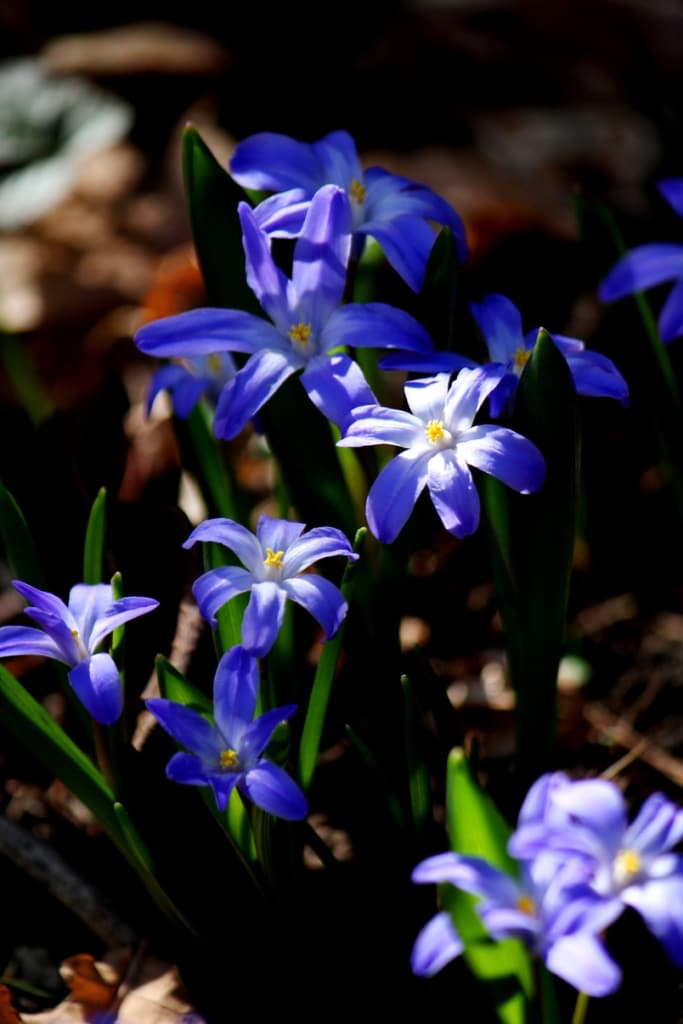
It’s high season for minor bulbs in my garden, the kind I need to plant only once, counting on to spread into colonies of long-lasting flower carpets year after year. That might sound like fantasy — but it happens!
First among these obliging spreaders is glory of the snow (Chionodoxa forbesii), which has up-facing French blue flowers with gleaming white throats. I once planted a package of a pink cultivar, C. ‘Pink Giant’, but it hasn’t pleased me very well. The flowers are larger than the blue species, but the pink colour is too pale, and the bulbs don’t spread at all (perhaps the result of hybridizing). But honestly, I shouldn’t whine about anything that comes up reliably in early spring!
Glory of the snow is joined by the familiar dark blue scilla (Scilla siberica) about a week later. The scillas march through everything and have infiltrated the ranks of Chionodoxa, blooming together to make a dynamic multi-hued blue carpet. Rising shoulder to shoulder with the scilla is Puschkinia scilloides, known as striped squill or Lebanon squill. If you’re not familiar with these little squills, it would a good thing to add some to your garden. Striped squills really are the icing on the cake, with their frilled white flowers with a light blue stripe through every petal. They look like white lace on the ground, and will be with you forever.
I’m all in favour of minor bulbs that naturalize through the beds, but I realize not everyone welcomes the spread of plants with a marching map of their own. So, where and how far do they go? In my garden, these minor bulbs seem to prefer moist, part-shade areas, and don’t venture out into dry soil and full sunlight. They will carpet a forest floor, if you happen to have one. The glory of the snow and striped squills stay within the garden beds, and I wouldn’t consider them invasive in a northern climate, although in warmer regions they are sometimes thought to be (it’s really a matter of climate and opinion).
The scilla are another matter, and after 20 years I do have single seedling scillas popping up occasionally in the lawn. I think it’s a charming effect and causes me no alarm. When I consider some of the more obnoxious plant constituents in the lawn (such as thistles), scillas are a welcome improvement. I hope they spread more quickly now they have a foothold.
I know after many decades, a spring scilla lawn can be the result of seedling spread. It doesn’t seem to discourage the growth of turf grass, which begins growing as the scillas finish, and the first mowing cuts them both. The scilla foliage disappears, and doesn’t crowd the grass or compete for moisture and nutrients. It’s an ideal plant partnership. I guess I’m just a wild thing.
Other posts by Judith this week:
Posts by Judith last week:

The naturalizing of the minor bulbs is one of our favourite gardening experiences. We have the similar sequence and in no way consider any of the spread to be a nuisance. Have you also noticed that Puschkinia have a delightful fragrance?
Hi Sharon (April 12),
Puschkinia have fragrance? I’m rushing right out to grab some and try it! That’s wonderful news, and thanks for letting me know. You’d think I would have noticed by now….
— Judith
Hi Sue,
I have the same fumewort (sometimes called bird in a bush), C. solida. It’s the ephemeral one, with pink-mauve flowers and glaucous foliage. It runs everywhere, and I just love it! Every trace of flower and foliage are gone by end of June, so it’s the perfect spring carpet. C. solida grows from tiny bulbs and all anyone needs is a few to get started. I also have two more fumeworts that I treasure — the well-known yellow flower, C. lutea, and its sister with a white and yellow flower, C. ochroleuca. Both of these grow from roots, and will exist in dry conditions where little else but weeds will grow. They’re lovely all summer and right up to frost. This mild winter past, several clumps growing out of cracks along the garage wall remained standing, and now are coming into bloom. What a wonderful group of plants these corydalis are!
— Judith
Oh, Judith, thanks for the great article.Yes, I adore my minor bulbs and try to make my choices on the phrase “natualize” when making my buys.
Unlike your squills, mine are rampant through my west-facing lawn. They are a great reminder of the randomness in the world. And Mother Nature does laugh at us when we plan.
Keeps us gardeners humble.
Hi Sheila (April 12),
Yes, humbled, and with an aching back! I’m in the process of riping out some “plants” that have grown a little too well. But the lovely spread of naturalized spring flowers does cheer me on.
— Judith
I have all 3 of these varieties growing in dry soil and full sun. They do naturalize there, but probably not as well as in your conditions. I also have a Corydalis elata (I think that’s the name) that naturalizes as well. It has pink and mauvy white corydalis flowers and bluish grey corydalis leaves and is blooming now. It will disappear completely in a few weeks.